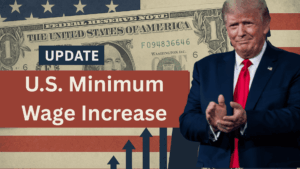Many Americans may soon see additional relief funds arriving in their accounts this November as federal authorities finalize a new round of direct deposit assistance. Designed to support middle- and low-income families, the New $2,000 Direct Deposit for U.S. Citizens aims to ease financial pressure amid continued inflation and rising living costs.
New $2,000 Direct Deposit for U.S. Citizens in November 2025
The Internal Revenue Service (IRS) and the U.S. Department of the Treasury are preparing to distribute a $2,000 direct deposit payment to eligible citizens in November 2025. While not officially branded as a “stimulus check,” this initiative is structured similarly to earlier relief programs, targeting individuals and families who meet specific income and filing requirements.
The goal is to provide timely support to Americans still recovering from the economic effects of inflation, high rent, and healthcare expenses. The payment will be automatically issued to eligible recipients through direct deposit or paper checks, depending on their last tax filing information.
Who Is Eligible for the $2,000 Direct Deposit
Eligibility for the $2,000 relief payment depends primarily on income limits, tax filing status, and citizenship.

To qualify, individuals must meet the following conditions:
- Must be a U.S. citizen or legal resident with a valid Social Security Number
- Must have filed a 2024 federal tax return
- Adjusted Gross Income (AGI) limits apply:
- Single filers: Up to $75,000
- Head of household: Up to $112,500
- Married couples filing jointly: Up to $150,000
Individuals earning above these thresholds may receive a reduced payment, while those exceeding higher income caps may not qualify at all.
Additionally, dependents claimed on eligible taxpayers’ returns could also receive partial benefits, similar to previous stimulus rounds.
Expected Payment Dates for November 2025
The IRS has indicated that payments will begin rolling out between November 10 and November 25, 2025, in batches based on filing and banking information.
| Payment Method | Expected Dates |
|---|---|
| Direct Deposit | November 10–18, 2025 |
| Paper Checks | November 20–25, 2025 |
Recipients who provided direct deposit details on their 2024 tax returns will receive the payment first, followed by mailed checks for others. The entire distribution process is expected to be completed before December 1, 2025.
How to Check Your Payment Status
Citizens can check their payment status using the IRS “Get My Payment” online tool once distribution begins. This system will display whether a payment has been processed, the payment method, and the estimated delivery date.
Those who changed banks or moved since their last tax filing are encouraged to update their information with the IRS as soon as possible. Incorrect or outdated details may cause delays or returned payments.
Why the Payment Is Being Issued
The $2,000 direct deposit payment is part of ongoing federal efforts to stabilize household budgets and stimulate economic activity. The government’s goal is to offset the impact of inflation on groceries, utilities, and healthcare costs, ensuring that working-class Americans maintain purchasing power.
This relief also supports local economies by encouraging consumer spending, which drives small business growth and job retention across various sectors.
IRS Instructions for Recipients
To ensure timely processing and avoid payment errors, recipients should:
- File all outstanding tax returns for 2024 before November 10, 2025.
- Verify that bank account and address details are correct with the IRS.
- Monitor official IRS updates rather than third-party websites to avoid misinformation.
- Retain payment confirmation for tax records, even though the relief amount will not be taxable.
The IRS has also reminded taxpayers that there is no fee or application form for receiving these payments. Scammers may attempt to exploit the program by promising early access or charging service fees — citizens should report such attempts immediately.
What This Means for Americans
For many households, the $2,000 payment will provide much-needed breathing room before the holiday season. Rising costs for rent, food, and healthcare have strained budgets nationwide, and these funds can help families manage essential expenses more comfortably.
While the payment is not expected to be a recurring stimulus, economic analysts believe it will significantly benefit lower-income earners and retirees living on fixed incomes.
The U.S. government’s renewed financial relief efforts demonstrate continued attention to the challenges facing average Americans, reinforcing confidence in federal economic support systems.
As the IRS begins rolling out the $2,000 direct deposit in November 2025, eligible citizens are encouraged to stay alert, verify their information, and watch for official updates.
Thank you for reading and staying informed about the upcoming $2,000 direct deposit payment and its impact on U.S. households.





